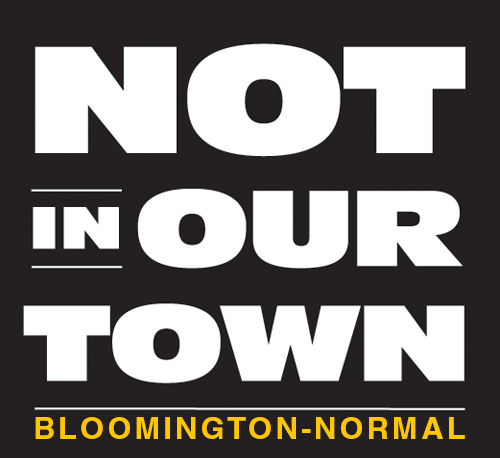It was a different sort of luncheon and home tour recently at Bloomington’s First Christian Church. The luncheon was sloppy joes and three-bean salad, the home could fit roughly in perhaps two church parking spots, and the guests were a mix of city officials, church volunteers, representatives of west side non-profit groups, and guests who spent much of their days – and nights – on the streets.
Local contractor and volunteer mission builder Mike Robinson displays the Tiny House interior for representatives of non-profit organizations.
Redeemer Lutheran Church Tiny House volunteer chats outside the prototype home.
Members of three area churches are currently putting the internal finishing touches to the Tiny House – a modular one-room frame home equipped with AC, heating, a toilet, and shower, designed to put a roof over one currently homeless head. The Tiny House Project – built on the Illinois Wesleyan University campus with private and city support – will go on tour with an eye toward finding a lot and hookups for permanent or transitional residency.
“This is a good thing you guys are doing,” one guest told Tiny House sponsors prior to the home tour.
The Tiny House will be on display for two weeks at a time at various Bloomington-Normal churches, as project coordinators consider options for occupancy. “We actually haven’t thought that far yet,” admitted Tiny House Co-Coordinator Julie Robinson, whose husband, local contractor Mike Robinson, helped build and is now finishing the interior of the structure.
Robinson sees the tiny house as “a viable option” for persons who currently live outside, particularly during periods of inclement weather. City of Bloomington Code Enforcement Grants Coordinator Jennifer Toney sees even longer-term benefits of economic housing for homeless persons: “Housing is probably one of the most important things for an individual when they’re looking for a quality of life.”
Toney subscribes to a “housing first” model, arguing that those not “struggling with where they’re going to put their head at night” can focus on employment, community services, and financial security. “It levels the playing field a little bit.”
PATH Homeless Services Supervisor Lori Kimbrough characterized the Twin Cities’ current homeless situation as “pretty severe,” with some 20-25 people on the streets or “other places not meant for human habitation” on any given night. That number did not drop this past winter as it traditionally has on a seasonal basis, “and we’re looking for some permanent solutions to that problem,” Kimbrough said.
“The folks say who stay out on the street have huge barriers to housing – basically affordability is the biggest issue,” she noted. “They have extremely no to low income, so that doesn’t afford them a living situation or a permanent housing option.
“If the housing choices for a person are in a tent or in a shelter, these people prefer to choose a tent. If we could give them the option of affordable housing, I would say they’d prefer that option.”
Low building costs and floorplan/facilities simplicity also offer relatively low home maintenance costs – another plus for prospective Tiny House tenants trying to regain their financial stability, Kimbrough suggested. Inaugural tiny house projects to date “have worked fairly well” in communities such as Eugene, Ore., Madison, Wis., and Huntsville, Ala., the PATH supervisor maintained.
The City of Bloomington currently administers a federal Department of Housing and Urban Development Local Continuum of Care Grant, which provides about $300,000 per year in homelessness prevention services. Toney and colleagues are investigating possible local lots for tiny houses, preferably along a municipal bus line to accommodate employment and considering public safety issues “for everyone,” she related.
Early talk of the Tiny House Project intrigued Joe Teague, a smaller properties broker and property consultant with Road Runner Real Estate and member of Second Presbyterian Church in downtown Bloomington. Teague concedes that the tiny house concept “breaks a few rules” and poses challenges in zoning and potential liability but notes “I’ve been known to bend or break a few as I go along in life.”
“It’s using great ideas, using different ideas, and using people’s imaginations to tackle a very tough problem and to provide services for folks who are in very tremendous need,” Teague said. “It also benefits our community as a whole. This is not just let’s put people in a shelter – let’s find them serves, let’s make it holistic. I don’t care if you live in a 10,000-square-foot mansion or a 2,500-square=foot nice house, or a cabin – sense of place is so critical. It’s a springboard.”


